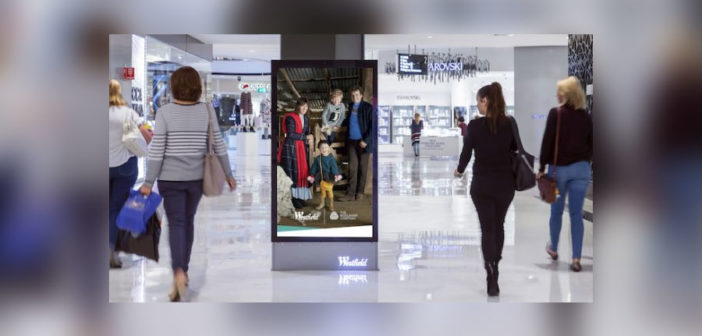Marketing speaks with Westfield’s Bronwyn Cooper and BrandSpace’s Jonathan Case about how smart brands are reimagining their approach to retail marketing in shopping centres.
This article was sponsored by Scentre Group to let readers know about its specialist division, BrandSpace »
Customers making their way through shopping centres are in a discovery mindset, and the brands that will engage with them on the right levels are those that use the available tools to deliver contextually relevant material. Bronwyn Cooper, head of content and programming at Scentre Group – owner and operator of Westfield in Australia and New Zealand, and Jonathan Case, head of sales at BrandSpace – the division of Scentre that works with brands to create meaningful connections with customers in Westfield locations – tell Marketing how smart brands are reimagining retail, and the tools and learnings available to them.
Marketing: How are smart brands re-imagining retail?
 Bronwyn Cooper: Our customers look to be inspired. They look to be entertained and they look to spend quality time with friends and family in their community. When we are working with brands, the smart ones recognise the potential of a reimagined retail environment to connect with an engaged customer base at scale.
Bronwyn Cooper: Our customers look to be inspired. They look to be entertained and they look to spend quality time with friends and family in their community. When we are working with brands, the smart ones recognise the potential of a reimagined retail environment to connect with an engaged customer base at scale.
The Woolmark Company is an example of one of these brands. Celebrating the growers who produce the fibre and the designers who use it, we work with The Woolmark Company to bring wool to life end to end.
We will shoot at a sheep station, capturing shearing moments, and the families that grow up with wool. We create content that showcases the different ways in which wool can be part of our customers lives off the back of those shoots, that lives within and outside of our centres.
We align in-centre activations and work with The Woolmark Company on Wool Week, showcasing the heritage, versatility and ways in which customers can use wool through events and activations to visual merchandising featuring retailer product.
The Woolmark Company recognises that through working with us and by leveraging the most of our environment, it can deliver compelling storytelling for our customers as they connect product in-store – from activewear to homewares – to the origin of wool.
How should marketers approach shopping centre advertising differently compared to other OOH media?
 Jonathan Case: The key difference between the Westfield environment and interchangeable or substitutable outdoor options really comes back to the audience that we reach.
Jonathan Case: The key difference between the Westfield environment and interchangeable or substitutable outdoor options really comes back to the audience that we reach.
The audience in our centres are choosing to be there. They make that choice to come and spend time in our centres with the purpose of shopping or engaging with brands. They are in the discovery mindset. They are not feeling rushed or interrupted. They’re travelling at a pace where they can be receptive to messaging from other brands. They are in there enjoying the environment. We are caretakers of that experience and place utmost importance that their experience is positive.
One-third of the content on our advertising network is owned by the Westfield brand and is used to communicate to our shoppers and support our retailers.
Advertisers can take advantage of the knowledge we utilise as the Westfield brand to connect more effectively with our audience. It’s a far greater sort of partnership approach, where our audience and the brand’s audience are interlinked.
Good advertising in our centres should add to the experience and make customers want to return, buy or spend longer in-centre. Rather than just being a sales organisation, we take a longer-term view. We have a long history of owning and operating our centres and look to partner with brands that are also in the long game.
What kind of learnings are you talking about?
JC: Campaign effectiveness. To enrich our audience understanding, we’ve created bespoke partnerships with several third-party research and data providers. These partnerships enable us to match our customer journey knowledge with brand preference, and to understand the relationship between different brands.
For example, we know that if a customer holds membership to a specific gym, they have a high propensity to shop at laser clinics, beautician services, athleisure and more. This helps brands be more effective in targeting their customers, not just in proximity to the front door of the gym, but in many areas of the centre – in different mindsets or ‘modes’ – that allow them to communicate varied messaging as well.
The traditional approach to retail was ‘put me outside the store, help me drive traffic’. Successful? Proven? Yes. A little limiting and not making the most of the opportunity? Probably! Think about a FMCG brand on-shelf. Traditionally, they’re promoted in and around the area, but what else? Where else in the shopping centre is that relevant and how do we help brands understand that? What about brands that are not traditionally found in a shopping centre?
Take automotive brands, for example. Historically automotive brands know that the best way to sell a car is to get someone to come and look at the car, however they know this is becoming increasingly difficult to convince people to do. They want to find ways of getting the car to people, to find the best locations in the centre that best align to that brand and that audience. For example, placing a luxury car in a luxury precinct or a SUV near brands that promote an adventurous lifestyle.
What this also means is that we understand the power of a well precincted centre. Precincting means placing brands together that have a high likelihood of cross-shopping. There are big differences in the strength of precincting across the shopping centre landscape. We have always understood that customers prefer to shop and spend more time in centres that are better precincted.
How are the best brands using data?
JC: Smart brands are relying on smart data. They engage in our space to fulfil a range of needs, and our data enables brands to connect with their target audience across those journeys.
They use data, first and foremost, to pick the right centres to be in. Rather than being in as many centres as possible, they are asking ‘where is a higher index and a higher overall number of the particular audience I’m targeting?’ We use Roy Morgan data to help us identify this, enabling brands to concentrate their investment and drive effectiveness.
Next, we focus on precincts or locations within the centre and the right screens, with all decisions being made using smart data.
How should brands plan campaigns to better leverage such a landscape?
BC: As well as recognising location, also recognise that different touch points – whether it’s large format screens, small format screens, directories or the role of a website or Wi-Fi platform within our environment – all play different roles in the customer journey. Content in context is critical.
We also know that location is an incredibly strong predictor of intent, whether that is purchase or other behavioural intent. With the ability to utilise our different touch points differently, we can create a breadth of different effects.
It may be that we need to help brands engage with customers before they visit. So, they may be looking for more inspirational information around a particular category. It may be something to do with the moment that they arrive and how the touchpoints they would utilise in that situation differ. The content should be complementary to that experience.
Location is absolutely number one. The second key point of context is time. In a fully digitally-enabled network, time is a strong indicator of people’s propensities towards different behaviours. If content is more relevant through parts of the day or through different days of the week, then it starts to become a lot more effective in capturing customers.
What tools are available to brands?
JC: The BrandSpace team works closely with our brand and agency partners to power their campaigns with our environment and audience knowledge. Through our partnership with Quantium we have developed an optimised campaign planning capability that enables brands to find their most receptive audience at the click of a button. Our teams can immediately see the best screens to meet the brief, the availability of those screens, and if there are any competitive conflicts.
We are also seeing fantastic campaign results when brands have trusted us with their audience profiles, which allow us to do a look-a-like exercise and match this audience with our own customer segments, helping to develop insights and plan appropriately.
BC: We don’t tend to subscribe to many ‘off the shelf’ data products because of the level of innate knowledge that we have as owner/operators. A lot of the intuitive data comes from experience running these campaigns and engaging with customers for decades.
Combining data with the application of our own information and our own knowledge of what our customers are doing creates insight for brands. We invest in both first-party and third-party opportunities, but we always know that as an owner-operator, and a brand owner, the expectations on us are often rightly, higher.
JC: We have also invested in an entire test facility to maximise the potential of our screens. An off-site environment affectionately referred to as ‘the lab’, a closed network where we invite agencies or their brands to come out, trial different pieces of creative and see how they look on the screen. Once brands see their ad live, they tend to go off and refine it.
Are there any patterns with the changes by brands and agencies after seeing samples of their creative?
BC: There are definitely trends within categories. Beauty and fashion brands tend to rely on a lot of full motion, full bleed video. While FMCG brands may not always consider this as their first style of execution in retail out of home.
However, FMCG and beauty brands are not that dissimilar when you think about the channels through which they are primarily sold – supermarkets and department stores. They both need to engage in very competitive environments.
We have worked with many FMCG brands who have seen how compelling full bleed video looks on the screen and have then thought differently about how to execute creative.
A lot of our partners are heavily engaged with creating video content now because they see how compelling it looks within the environment. That’s not to say that there isn’t a role for static. Different styles of communication require different creative cues. But the opportunity to have at least a level of motion within that execution – even if it’s a cinemagraph or animated iconography – that catches the eye more and gives people a better reason to actually engage with that content is recommended.
–
This article first appeared in www.marketingmag.com.au
Seeking to build and grow your brand using the force of consumer insight, strategic foresight, creative disruption and technology prowess? Talk to us at +9714 3867728 or mail: info@groupisd.com or visit www.groupisd.com




